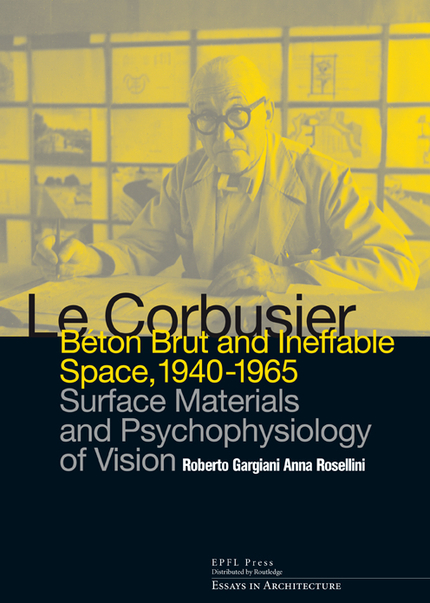Présentation
This groundbreaking essay on Le Corbusier provides a new perspective that is based on exhaustive archival research and the study of neglected or completely unknown documents stored at the Fondation Le Corbusier. This source of documents has proven to be extremely valuable, with information on the aesthetic principles of Le Corbusier during the post World-War-II period, explaining his manner of defining the final artistic quality of the work directly at the construction site, as if he were dealing with a sculpture or tableau.Béton brut, a term invented by Le Corbusier himself at the beginning of the 1950s to designate his own particular use of exposed concrete, is analyzed from all angles for the first time: its fabrication with a rigorous selection of its constituent materials; its final form and positioning of the formwork in order to obtain the desired textural imprint; and the treatment of the surface with special types of paint. The essay also delves into the project management and the construction of several buildings in the period 1940-1965. Each worksite, from the Unité d'Habitation (Housing Unit) at Marseille to the city of Chandigarh, and also including the Tokyo museum, the Carpenter Center in Cambridge and the Unité d'Habitation at Berlin, are analyzed in detail. In this volume, the associates, the enterprises, and even the masons become the actors of a complex creative process that Le Corbusier directs with mastery. All the forms of artistic expression that converge into what Le Corbusier defines as the espace indicible (ineffable space) are commented and documented, from the insertion of the basic materials such as the tapestries and paint in the qualification of these spaces, to the way in which photography is used to study the unexpressed potentialities of his own architecture and paintings. Indeed, Le Corbusier was able to integrate, in the genesis of the space and in the quality of the construction materials, the principle contemporary artistic phenomena, such as the automatisms of Breton and Dubuffet, the musique concrète of Varèse, Klein's research on monochrome art, Pop Art and the transfer concept. It is thus a new vision that the essay reveals about the last and fundamental works of Le Corbusier which have, paradoxically, been less studied than his earlier work. In this volume, the questions of optics, artistic vision, and the psychophysiology of perception are studied, at last, in parallel with the technical questions of the materials used in his various works. This approach reveals the existence of a series of theoretical questions about the artistic process, ignored until now, that are shown to be indispensable for the complete understanding of the work of Le Corbusier during the period following World War II.
Sommaire
- The discovery of béton brut with malfaçons : the worksite of the Unité d'Habitation at Marseille
- Entraînement d'acrobate : the provocateur des formes neuves
- Unités d'Habitation at Rezé-lès-Nantes, Berlin and Briey-en-Forêt
- Chandigarh, or the cosmic vision
- Epiderme brutal in pisé, brick and wood
- Machines à habiter for vision and tropical climates
- Automatisms and the projection of sound and image
- Towards a nouvelle stéréotomie.
Informations
Editeur : EPFL Press English Imprint
Collection : Architecture
Publication : 14 octobre 2011
Edition : 1ère édition
Support(s) : Livre papier
Nombre de pages Livre papier : 604
Format (en mm) Livre papier : 170 x 240
Poids (en grammes) : 1490
Langue(s) : Anglais
EAN13 Livre papier : 9782940222506
Du même auteur
Rem Koolhaas/OMA The Construction of Merveilles
52,15 €
matières 14 L'oeuvre et le temps
Bruno Marchand, Roberto Gargiani, Jacques Lucan, Luca Ortelli, Martin Steinmann
28,35 €
matières 13 Effets d'échelle
Bruno Marchand, Roberto Gargiani, Jacques Lucan, Luca Ortelli, Martin Steinmann
37,50 €
The Rhetoric of Pier Luigi Nervi Concrete and Ferrocement Forms
Roberto Gargiani, Alberto Bologna
113,74 €
Dans la même collection
New Brutalism The invention of a style
52,15 €
Unearthing traces Dismantling imperialist entanglements of archives, landscapes, and the built environment
À partir de 0,00 € (gratuit)
Higher Knowledge SANAA'S Rolex Learning Center at EPFL since 2010
19,91 €
Gardens of War British Cemeteries on the Western Front
66,35 €
Choosing Architecture Criticism, History and Theory since the 19th Century
63,51 €
Ils ont aussi acheté
Dîner avec Darwin Des cavernes aux cuisines, ce que racontent nos assiettes
18,90 €
Les dispositifs du confort dans l'architecture du XXe siècle:connaissance et stratégie de sauvegarde Building Environment and Interior Comfort in 20th-Century Architecture: Understanding Issues and Developing Conservation Strategies
56,00 €
German concrete, 1819-1877 The Science of Cement from Trass to Portland
99,53 €
The Rhetoric of Pier Luigi Nervi Concrete and Ferrocement Forms
Roberto Gargiani, Alberto Bologna
113,74 €
Sur des thèmes similaires
New Brutalism The invention of a style
52,15 €
Interoperability An introduction to IFC and buildingSmart standards integrating infrastructure modeling
Bernd Domer, Rachele Bernardello
42,65 €
Unearthing traces Dismantling imperialist entanglements of archives, landscapes, and the built environment
À partir de 0,00 € (gratuit)
Studies on types Dormitories
À partir de 0,00 € (gratuit)






